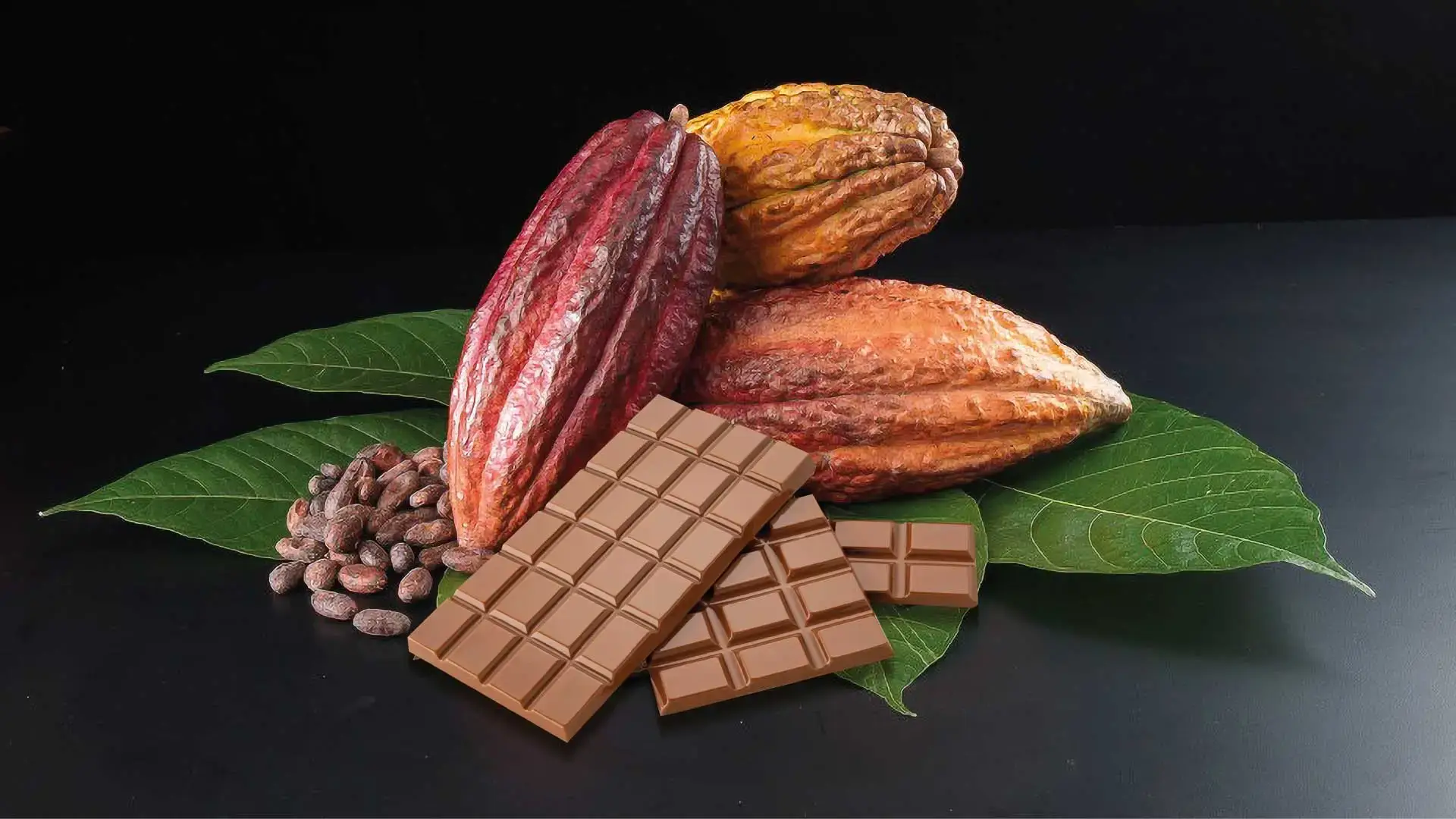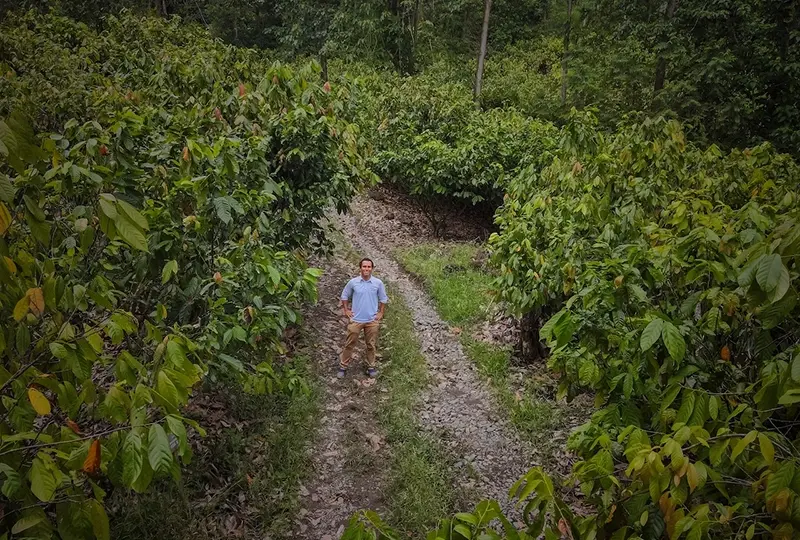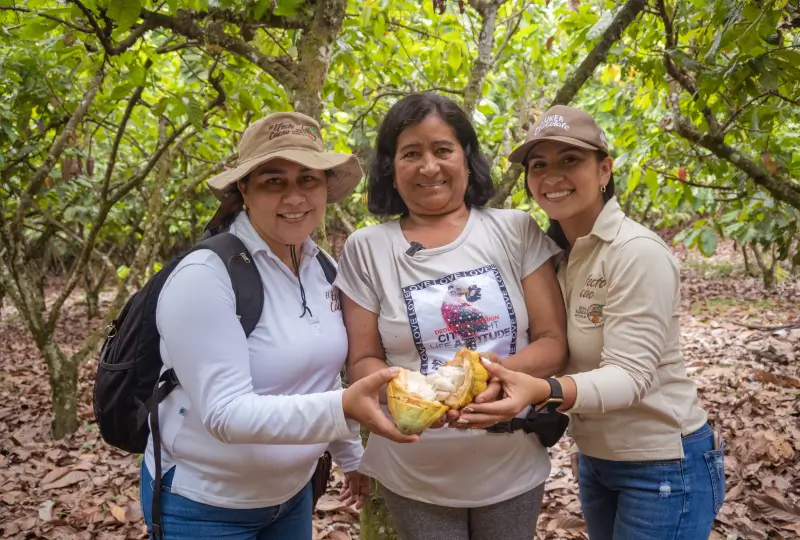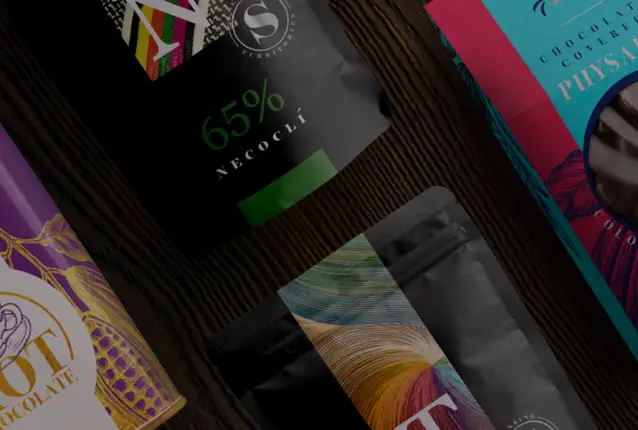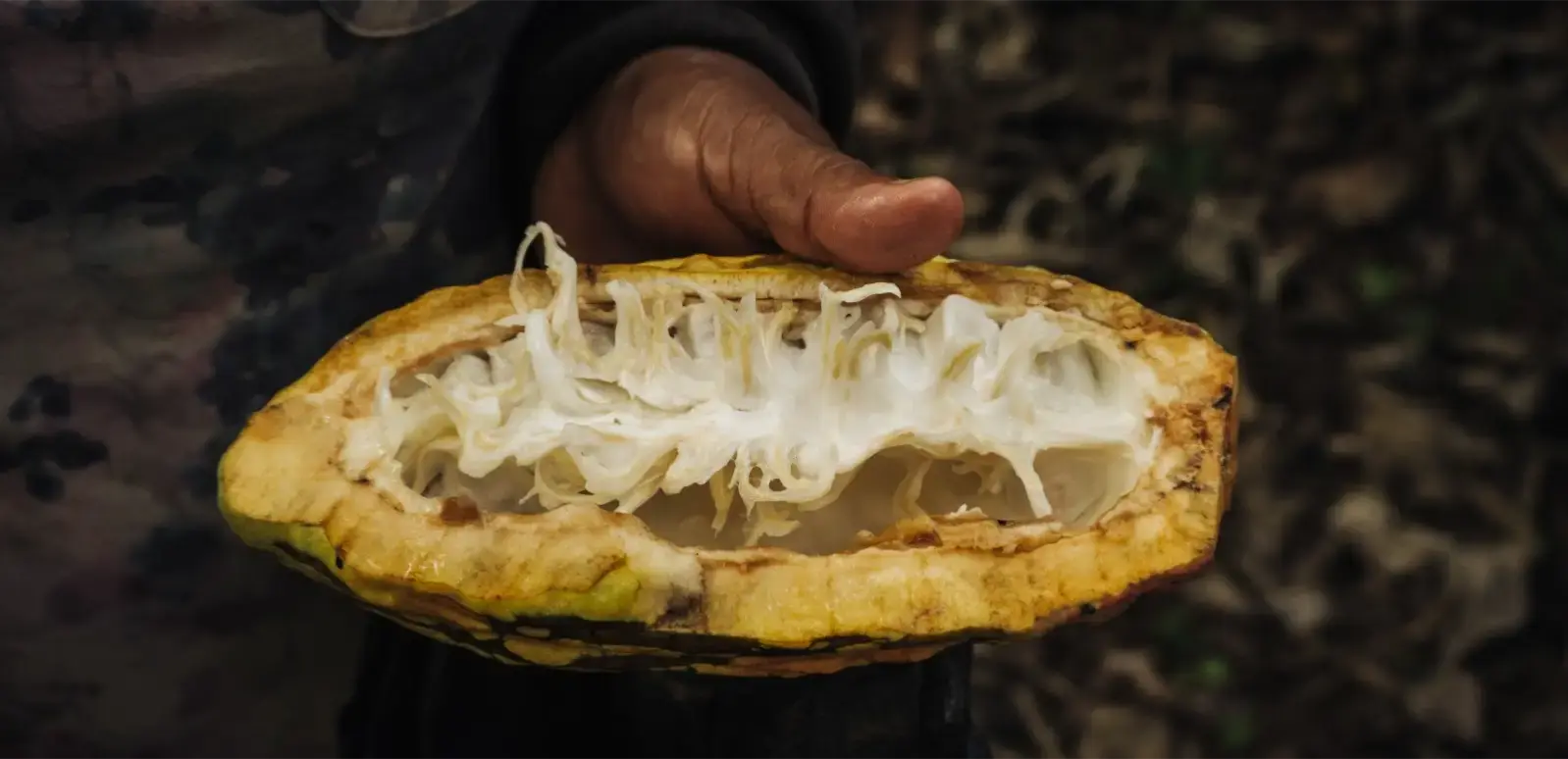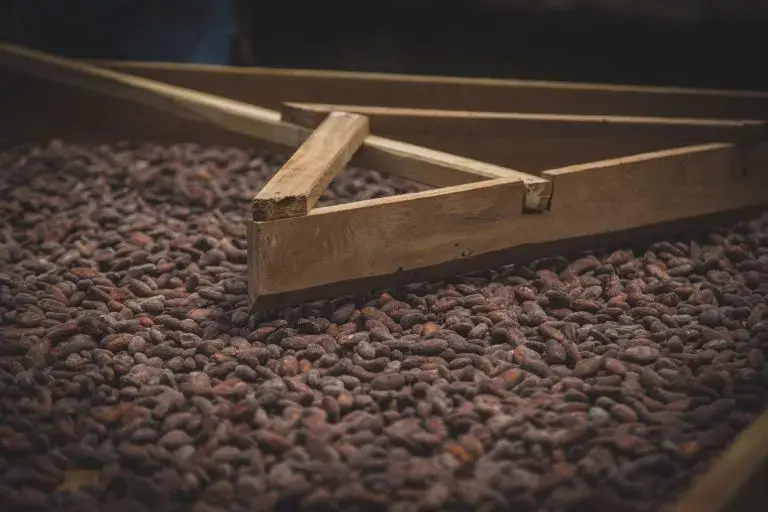Organic chocolate certifications give your product credibility. But navigating different regional standards, from USDA Organic to EU regulations, can feel like a maze, especially when you’re also balancing growth, formulation, and values-led decision-making.
This guide breaks down the main organic certifications by geography, what they mean for chocolate products, and how to strategically choose the right pathforward so you can focus on creating chocolate that’s indulgent, market-ready, responsible, and built to last.
📘 In this guide, you’ll find:
- Why organic certification matters (and how it helps you grow with purpose)
- Key certifications by geography: US, Canada, EU, UK, and ROC
- What Certifiers Look For and How to Prepare
- Organic Chocolate Applications: Where the Market Is Headed
- How Organic Chocolate Brands Can Lead with Sustainability and Transparency
Let’s start by exploring what makes certification a growth decision, not just a regulatory one:
1. Why Organic Certification Matters for Challenger Brands
For challenger brands, organic certification isn’t just a box to tick. It’s a strategic move that brings your values to life on your product, in your supply chain, and in the eyes of increasingly conscious consumers.
Today’s buyers want to know what’s behind the label: where the ingredients come from, how they’re grown, and whether those choices align with their personal priorities. And the numbers show it’s more than a niche. According to FMCG Gurus (2024), 70% of global consumers are actively seeking natural and organic ingredients, while 62% associate ‘organic’ with higher quality and better health (Voice of the Consumer, 2025).

But here’s the real driver: trust. Organic certification builds credibility with retailers, partners, and end consumers alike. It sends a clear message—your product was made with care, under standards designed to protect both people and planet.
And it’s not just about what’s left out. Certified organic chocolate invites a different kind of creativity—cleaner labels, functional ingredients, and plant-based formats that feel indulgent, not restrictive. It can even make it easier to scale across borders, with globally recognised standards acting as a passport to new markets.
Most importantly, it helps your brand stand for something—clearly, confidently, and in a way that travels with your product.
2. Certification by Region: What You Need to Know
If you’re planning to launch or scale an organic chocolate product, knowing which certification applies to your target market is step one. While most standards share a common goal—no synthetic pesticides, GMOs, or artificial additives—each region has specific rules you’ll need to follow.
Below is a breakdown of the most relevant certifications for chocolate brands, including key requirements, certifying bodies, and what to expect during the process.
🌍 EU Organic (European Union)

Used for: Selling in EU member countries
Regulated by: European Commission – Regulation (EU) 2018/848
Minimum organic content: 95%
Must include: EU organic logo, certifier code, origin of raw materials
📌 Key requirements:
- Cocoa and all other ingredients must be certified organic.
- No artificial preservatives, synthetic solvents, or genetically modified inputs.
- Supply chain traceability and full documentation are mandatory.
- Certification is granted by authorised control bodies in each EU country.
Tip: This is one of the most recognised seals globally. If you plan to export to Europe, the EU Organic label signals premium quality and compliance.
🇺🇸 USDA Organic (United States)

Used for: Selling in the U.S.
Regulated by: USDA – National Organic Program (NOP)
Minimum organic content: 95%
Must include: USDA Organic seal, certifier name, and handling facility (if different)
📌 Key requirements:
- All agricultural ingredients must be certified organic.
- Non-organic substances must appear on the NOP’s “National List of Allowed Substances.”
- Strict rules around facility segregation and cleaning protocols.
Fun fact: According to the Organic Trade Association (2024), over 80% of U.S. households purchase organic products. That means your chocolate could be expected to carry this seal—especially if you’re working with large-scale distributors or premium retailers.
🇨🇦 Canada Organic

Used for: Selling in Canada
Regulated by: Canadian Food Inspection Agency (CFIA)
Minimum organic content: 95%
Must include: “Canada Organic” logo or a recognised equivalent (e.g., USDA Organic via equivalency)
📌 Key requirements:
- Similar to USDA standards, with a focus on clean supply chains and no GMOs.
- Canada has equivalency agreements with the U.S., EU, UK, Japan, and others—meaning if you're already certified under those systems, you're often eligible in Canada too.
Why it matters: If you're building a multi-market portfolio, this certification makes expansion smoother.
🌱 Regenerative Organic Certified™ (ROC)

Used for: Brands going beyond “organic”
Regulated by: Regenerative Organic Alliance (ROA)
Minimum requirement: USDA Organic certification is a prerequisite
Focus areas: Soil health, animal welfare, and social fairness
📌 Key requirements:
- Builds on USDA Organic but adds strict criteria around regenerative practices.
- Requires long-term commitment to biodiversity, fair trade, and ecosystem restoration.
- Certification available at three levels: Bronze, Silver, and Gold.
Why ROC matters: If your brand story includes regenerative agriculture or cocoa grown with ecosystem impact in mind, this label backs up those claims. It’s also an emerging trust marker for next-gen consumers looking beyond traditional sustainability badges.
Summary Table: Organic Certification by Region
|
Market |
Certification |
Organic Content |
Key Certifying Bodies |
Cross-Market Equivalency |
|
European Union |
EU Organic |
95% |
ECOCERT, Kiwa BCS, others |
With U.S., Canada, UK |
|
United States |
USDA Organic |
95% |
Oregon Tilth, CCOF, others |
With EU, Canada, Japan |
|
Canada |
Canada Organic |
95% |
ECOCERT Canada, Pro-Cert |
With U.S., EU, UK |
|
Global (Optional) |
ROC (Regenerative Organic) |
95% + regenerative |
ROA partners |
Must hold USDA Organic first |
📌 Looking or certified organic chocolate products in your market?
3. What Certifiers Look For and How to Prepare
A step-by-step guide to help growing brands meet organic certification requirements—whether you're producing in-house or partnering with a manufacturer.
 Getting certified isn’t just about having the right ingredients. It’s about proving that every part of your process—from sourcing to packaging—meets rigorous standards. Here's what certifiers will look for, and how to make sure you're ready.
Getting certified isn’t just about having the right ingredients. It’s about proving that every part of your process—from sourcing to packaging—meets rigorous standards. Here's what certifiers will look for, and how to make sure you're ready.
1. Ingredient Traceability
What it is:
Certifiers need to know exactly where your ingredients come from and how they were handled.
What they’ll expect:
- Organic certificates from accredited suppliers
- No use of GMOs, synthetic fertilisers, or prohibited inputs
- Complete records showing origin and handling for each ingredient
Pro tip:
Platforms like Luker Trace can help you keep digital records of your cocoa’s origin, traceability data, and supply chain partners—all in one place.
2. Separation of Organic and Non-Organic Ingredients
What it is:
Preventing contact between certified and non-certified ingredients.
What they’ll expect:
- Separate storage or clearly labelled containers
- Dedicated production lines or validated cleaning procedures
- Documented SOPs covering storage, handling, and transport
Pro tip:
If you’re using a shared facility, make sure your production schedule places organic runs before non-organic, or that purge processes are documented and validated.
3. Preventing Cross-Contamination
What it is:
Protecting your organic product from allergens or residues that can compromise its status.
What they’ll expect:
- Clear cleaning logs and allergen management plans
- Lab testing where needed (e.g., swabs for lactose or soy)
- Records proving that your facility prevents unintended contact
Pro tip:
Our in-house lab is ONAC-accredited for cadmium, salmonella, and lactose protein content—so your product is backed by verified safety standards.
4. Full Documentation & Audit Trail
What it is:
Certifiers will check how well you track each batch—from raw ingredients to finished goods.
What they’ll expect:
- Batch records with weights, operator names, and time logs
- Ingredient receipts and processing logs
- Samples of your labels, packaging, and certifications
Pro tip:
Digital logs make audits easier and future scaling smoother. If you’re growing fast, this will save time and reduce errors.
5. Organic-Specific Labelling
What it is:
Your label must reflect the certification correctly depending on the market you're targeting.
What they’ll expect:
- The percentage of organic ingredients clearly stated
- Use of approved logos and certifier code
- Accurate details about where the product was made or packed
Pro tip:
Small missteps, like a missing certifier code or incorrect logo size—can delay your launch. Get your label reviewed before printing.
📋 Quick Compliance Checklist
|
Requirement |
Ready? |
|
Organic supplier certificates |
✅ / ⬜ |
|
Ingredient traceability documentation |
✅ / ⬜ |
|
Segregation and sanitation protocols |
✅ / ⬜ |
|
Allergen and contaminant test records |
✅ / ⬜ |
|
Full audit trail and batch logs |
✅ / ⬜ |
|
Organic labelling and logo checks |
✅ / ⬜ |
📌 Next Step: Need a supplier that aligns with your process and certification standards?
Explore our certified organic manufacturing capabilities →
|
Understanding Regenerative Organic Certification (ROC) What it is: Why it matters: What they’ll expect:
Certification body: Pro tip: |
4. Organic Chocolate Applications: Where the Market Is Headed
Organic chocolate isn’t just for bars anymore. As the market matures, we’re seeing certified chocolate find new life in snackable formats, functional inclusions, and clean-label applications. For challenger brands looking to differentiate, this opens the door to innovate in spaces where indulgence meets intentionality.

🍫 Snacking Is Getting Smarter
Snacks are evolving from guilty pleasure to daily ritual—and organic chocolate is part of that shift.
Top formats gaining traction:
- Clusters & bites: Made with puffed grains, seeds, or nuts for mindful indulgence
- Nut butter cups: Organic coatings pair with plant-based fillings
- Dragees: Whole ingredients coated in certified chocolate (e.g., almonds, cranberries)
💡 Did you know? Organic snack launches rose by 11% in 2023, with chocolate-covered formats leading the category (Innova Market Insights, 2024).
🍫 Bars with a Story—and a Purpose
The classic chocolate bar is evolving. Today, bars serve as a storytelling platform for values-driven brands.
Trending inclusions and themes:
- Textural contrast: Think quinoa crisps or caramelised hazelnuts
- Botanical blends: Lavender, turmeric, hibiscus—organic and sensory
- “Organic +” positioning: Added protein, adaptogens, or prebiotics
Organic bars with layered functionality are winning with consumers looking for snacks that do more—satisfy cravings, fuel lifestyles, and reflect values.
🍪 Clean Label Meets Function in Bakery & Frozen
In the world of bakery and frozen applications, organic chocolate chunks, chips, and shavings are being used in:
- Protein cookies and bars
- Organic granola mixes
- Frozen bakery goods like muffins or scones
Brands want ingredients that can withstand the heat—without losing flavour, texture, or certification. That’s why at Luker, our organic chips are developed for high baking performance, clean labels, and traceability.
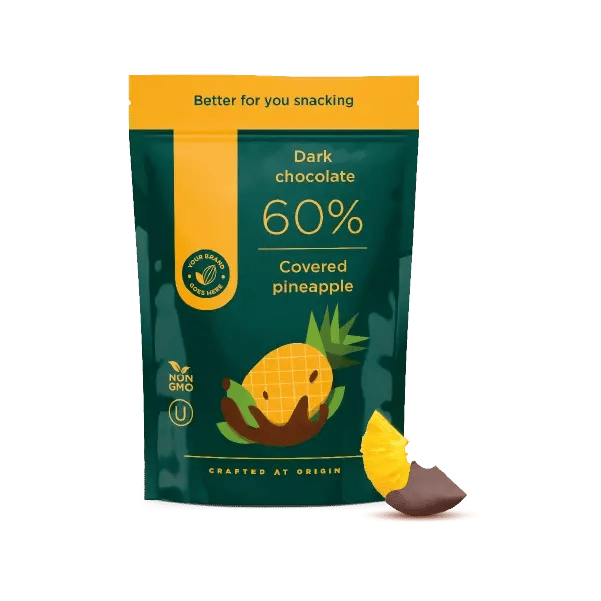
🍇 Chocolate-Coated Fruits: A Growing Niche
Dried fruit coatings offer nostalgic, portion-controlled indulgence with a clean conscience.
Popular formats include:
- Raisins, mulberries, or orange peel in 70%+ dark organic chocolate
- Kid-friendly packs with certified claims
- Premium giftables with single-origin messaging
They’re gaining ground with health-conscious shoppers looking for sweet-but-natural alternatives.
5. How Organic Chocolate Brands Can Lead with Sustainability and Transparency
Organic chocolate isn’t just about eliminating synthetic pesticides or checking off a certification box. For today’s most conscious consumers, it’s about the bigger picture—how your chocolate is grown, sourced, made, and communicated. Sustainability and transparency aren’t add-ons; they’re expected.
For challenger brands, this is an opportunity. Not just to meet organic standards, but to lead with purpose—showing real impact, not just compliance. That means connecting the dots between organic farming practices, regenerative cocoa systems, traceability, and the people behind each ingredient.
Here's how to go beyond the label and show what your brand stands for.
🌱 Organic & Regenerative Agriculture: A Natural Pairing
Certified organic farming supports:
- Healthier soils
- Biodiversity preservation
- Reduced chemical runoff
But regenerative agriculture takes it further—building resilient ecosystems through agroforestry, composting, and polyculture models. It's about restoring what’s been depleted.
Regenerative Organic Certification (ROC) is now emerging as a gold standard. ROC-certified products must:
- Be certified organic
- Follow rigorous soil health and animal welfare protocols
- Show fair conditions for farming communities
If your brand is exploring the next step beyond standard organic, ROC can add meaningful value and differentiation.
🔎 Transparency: From Bean to Bar
Modern consumers want visibility into every step of the value chain.
At Luker, we’ve seen this first-hand. That’s why we developed Luker Trace, a platform that gives full transparency into:
- Cocoa origin and farmer associations
- Lot-by-lot traceability
- Environmental indicators like forest density
QR codes or digital traceability tools can turn transparency into a powerful part of your brand story—especially for those marketing to purpose-driven consumers or seeking B2B differentiation with retailers and co-manufacturers.
.webp?width=1920&height=1080&name=Luker-trace-system-polygons%20(1).webp)
🤝 Empowering the People Behind Organic Chocolate
True sustainability starts with producers. Many smallholder farmers face high barriers to transition to organic or regenerative farming—training, certification costs, and long-term market access among them.
Brands can make a lasting difference by:
- Supporting field schools and capacity-building
- Partnering on organic pilot projects and agroforestry design
- Offering stable, forward contracts and fair pricing
For example, Luker’s work in The Chocolate Dream helps farmers transition to organic systems while increasing resilience, income, and land health—proving that growth and impact go hand in hand.
♻️ Sustainable Packaging & Operations
Organic isn’t limited to ingredients. From packaging to logistics, your brand’s sustainability story extends across every touchpoint.
Areas to explore:
- Compostable or plastic-free wrappers
- Carbon-smart manufacturing partners
- Ethical sourcing of non-cocoa ingredients like sugar, dairy alternatives, or inclusions
Consumers are paying attention. According to Innova’s 2024 Sustainability Report, 41% of global chocolate buyers expect brands to go beyond organic and actively demonstrate climate and social impact.
👉 Learn more about how Luker’s sustainability model supports certified organic chocolate from the ground up.
In a fast-changing market, organic certification isn’t just a label—it’s a strategic tool.
For challenger brands—whether you're manufacturing in-house or partnering with a co-manufacturer—certification offers a way to build trust, stand out, and grow with purpose. It reflects what today’s consumers care about most: clarity, quality, and conscience.
From snacking innovations to plant-based inclusions and better-for-you formats, certified organic chocolate lets you:
- Signal ingredient integrity and sourcing values
- Align with clean-label and sustainability expectations
- Open doors to retailers and markets requiring certification for coding
But as we’ve seen, success goes beyond checking off requirements. It means being ready for audits, choosing the right certifier, and embedding organic into your supply chain, storytelling, and product development.
Whether you’re exploring your first certified line or scaling an existing organic product, the opportunity is real—and growing.
